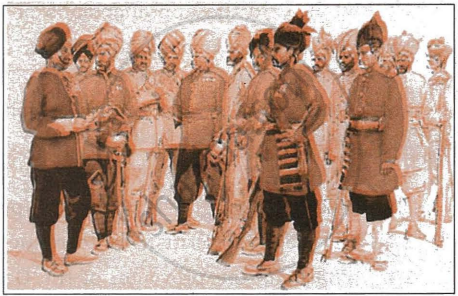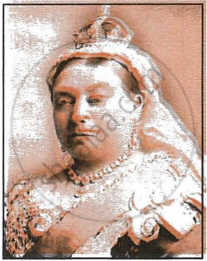Advertisements
Online Mock Tests
Chapters
▶ 1: The First War of Independence, 1857
2: Growth of Nationalism
3: First Phase of the Indian National Movement
4: Second Phase of the Indian National Movement
5: The Muslim League
II. MASS PHASE OF THE NATIONAL MOVEMENT (1915-1947)
6: Mahatma Gandhi and the National Movement
7: Quit India Movement
8: Forward Bloc and The INA
9: Independence and Partition of India
III. THE CONTEMPORARY WORLD
10: The First World War
11: Rise of Dictatorships
12: The Second World War
13: United Nations
14: Major Agencies of the United Nations
15: Non-Aligned Movement
SECTION B - CIVICS : I. THE UNION LEGISLATURE
1: The Union Parliament
II. THE UNION EXECUTIVE
2: The President and The Vice-President
3: Prime Minister and Council of Ministers
III. THE JUDICIARY
4: The Supreme Court
5: The High Courts and Subordinate Courts
![Morning Star solutions for Total History and Civics [English] Class 10 chapter 1 - The First War of Independence, 1857 Morning Star solutions for Total History and Civics [English] Class 10 chapter 1 - The First War of Independence, 1857 - Shaalaa.com](/images/total-history-and-civics-english-class-10_6:f32d3458d7ba4c159209b7405ae151c7.jpg)
Advertisements
Solutions for Chapter 1: The First War of Independence, 1857
Below listed, you can find solutions for Chapter 1 of CISCE Morning Star for Total History and Civics [English] Class 10.
Morning Star solutions for Total History and Civics [English] Class 10 1 The First War of Independence, 1857 EXERCISES [Pages 21 - 24]
Multiple-Choice Questions.
The East India Company's territorial power began to increased rapidly in India after which of the following Battles?
The Battle of Buxar
The Battle of Plassey
The First Anglo-Mysore War
The Third Anglo-Maratha War
The First Indian State to enter into the Subsidiary Alliance with the East India Company was ______.
Awadh
Mysore
Tanjore
Jhansi
Lord Dalhousie annexed a number of Indian states to the East India Company using ______.
The Subsidiary of Lapse
The Doctrine of Lapse
The Government of India Act of 1858
Queen Victoria's Proclamation
Nana Saheb was the adopted son of ______.
Bahadur Shan Zafar
Tantia Tope
Baji Rao I
Baji Rao II
Where was the family seat of Nana Saheb located?
Nagpur
Lucknow
Pune
Kanpur
Which of the following reforms was resented by the Indians?
The Abolition of Sati
The Widow Remarriage Act
Opening of Girl's school
Both the Abolition of Sati and the Widow Remarriage Act.
Jhansi was annexed by applying which of the following?
Alleged Misrule
Subsidiary Alliance
Queen's Proclamation
The Doctrine of Lapse
Seventy-five thousand of the Company's sepoys belonged. to which of the following states?
Jaipur
Awadh
Mysore
Sambalpur
By the provisions of which of the following, 20,000 estates of the landlords were confiscated by the East India Company?
The Hunter Commission
Frazer Commission
The Inam Commission
The Woods' Dispatch
Which of the following Acts was resented by the Indian sepoys?
The General Service Enlistment Act
The Indian Service Rules
The Government of India Act, 1858
The Queen's Proclamation
Which of the following events of the Uprising of 1857 and their leaders is not correctly matched?
Lucknow − Begum Hazrat Mahal
Kanpur − Nana Saheb
Kalpi − Tantia Tope
Bihar − Khan Bahadur
Which of the following was the result of the Great Uprising of 1857?
End of the rule of the British Crown.
End of the rule of the East India Company.
End of the rule of the Governor-General.
End of the Board of Directors.
The Uprising of 1857 began from ______.
Meerut
Plassey
Buxar
Delhi
An effect of the Uprising of 1857 was that ______.
The spirit of rebellion in India was crushed.
The British became totally demoralised.
The British abandoned their repressive policies.
Unity was forged between the Hindus and Muslims.
Who introduced the Subsidiary Alliance in India?
Lord Hastings
Lord Amherst
Lord Wellesley
Lord Cornwallis
After the initial success of the Uprising of 1857, the objective of the leaders of the Uprising included.
Restoring the former glory to the Mughal empire.
Forming a Federation of Indian States under the aegis of Bhadur Shah II.
Eliminating foreign rule and return of the old order.
Establishing his own power in his respective region by each leader.
Under the Government of India Act 1858, who gave up the direct administration of India?
The East India Company
The British Crown
Lord Mountbatten
The Mughal Emperor
The Uprising of 1857 was a prolonged period of armed uprising against the British in Northern and Central India. Which of the following was not a major centre of the Uprising?
Delhi
Awadh
Mumbai
The Chambal Region
Short Answer Questions.
What was the nature of revolts against the British before the First War of Independence?
Why was the ‘war of 1857’ hailed as the first war of National Independence?
State any two political causes responsible for the First War of Independence.
Name two ways in which the British expanded their territorial power in India.
What was the subsidiary alliance?
Name two Indian States brought under the British control using the Subsidiary Alliance.
Explain the term doctrine of lapse.
Name the two states annexed by the British using the Doctrine of Lapse.
Who was Nana Saheb?
What was Nana Saheb's main grievance against the British?
Which policy was used by Lord Dalhousie against Rani Laxmi Bai?
Why did Rani Laxmi Bai become a bitter enemy of the British?
State two announcements which adversely affected the Mughal dynasty in India.
Mention any two consequences of the annexation of Awadh.
State any two consequences of the disbanding of the armies of the annexed States by the British.
Give the meaning of Absentee Sovereignty.
Why was absentee sovereignty resented by the Indians?
What were the apprehensions of Indians about the introduction of the railways?
Mention any two social reforms advocated by the British which affected the religious traditions of the Indian people.
Mention any two measures which point to the policy of social discrimination followed by the British in India.
Give two examples to show how the British exploited the resources of India.
Give any two grievances of the peasantry against the British.
What did the British do to reduce the landed aristocracy to poverty?
What was the provision of the General Service Enlistment Act which was resented by the Indian soldiers? Why was it resented?
Mention any two measures which point to the policy of social discrimination followed by the British in India.
State two effects of the British defeat in the First Afghan War on the Indian soldiers.
State two effects of the Punjab defeat in the First Afghan War on the Indian soldiers.
What was the immediate cause of the First War of Independence?
Who was Mangal Pandey?
What did Mangal Pandey do?
State two consequences of the First War of Indian Independence on the East India Company.
How was the Army organised after the First War of Independence?
What impact did the uprising of 1857 have on the Mughal rule?
What impact did the Uprising of 1857 have on the Peshwaship?
Mention any two drawbacks of the First War of Independence.
Structured Questions
Economic exploitation of the country produced discontent, resentment and resistance among the people that culminated in the Great Uprising of 1857.
- The ruin of trade and handicrafts.
- Impoverishment of the cultivators.
- Subordination of Indian economy to British interests (making India an agricultural colony of British capitalism).
The Great Outbreak of 1857 brought about important changes in the character of Indian administration and the future development of the country In this context, discuss:
- The changes introduced in the administrative set-up of the British territories in India.
- The changes in the Army.
- The changes in the relationship with the Princely States.
Although the First War of Independence of 1857 failed, it had important consequences for India. In this context, answer the following questions:
- How did the Uprising give rise to nationalism in India?
- How did the end of the East India Company's rule bring in grave economic perils in India?
- State how the British Government tried to pacify the feelings of Indians with regard to:
- their religious practices.
- the Princely States.
Picture Study
Study the picture and answer the following questions:

- Who are the persons in the picture? How were they treated by their British counterparts?
- State any three grievances they had against the British.
- What changes were brought in their status after the Uprising of 1857?
Study the picture and answer the following questions:

- Identify the person in the picture. Name the proclamation made by her in 1858.
- Where and by whom was this proclamation made public?
- What assurance did this proclamation give to the Indian people regarding
- religious freedom and
- appointment to public offices?
Thinking Skills
Imagine you were present when the rulers of Indian states met at a common place before the Uprising of 1857. Each ruler voiced his grievance against the British. Make a list of the grievances of each of the rulers.
Imagine you were a Subedar in the army hailing from a landed family from Awadh. State the grievances your father had against the British.
There were uprisings against the British in every corner of the country in the nineteenth century. Make a list of the uprisings in your locality and the manner in which the imperialists dealt with them.
Solutions for 1: The First War of Independence, 1857
![Morning Star solutions for Total History and Civics [English] Class 10 chapter 1 - The First War of Independence, 1857 Morning Star solutions for Total History and Civics [English] Class 10 chapter 1 - The First War of Independence, 1857 - Shaalaa.com](/images/total-history-and-civics-english-class-10_6:f32d3458d7ba4c159209b7405ae151c7.jpg)
Morning Star solutions for Total History and Civics [English] Class 10 chapter 1 - The First War of Independence, 1857
Shaalaa.com has the CISCE Mathematics Total History and Civics [English] Class 10 CISCE solutions in a manner that help students grasp basic concepts better and faster. The detailed, step-by-step solutions will help you understand the concepts better and clarify any confusion. Morning Star solutions for Mathematics Total History and Civics [English] Class 10 CISCE 1 (The First War of Independence, 1857) include all questions with answers and detailed explanations. This will clear students' doubts about questions and improve their application skills while preparing for board exams.
Further, we at Shaalaa.com provide such solutions so students can prepare for written exams. Morning Star textbook solutions can be a core help for self-study and provide excellent self-help guidance for students.
Concepts covered in Total History and Civics [English] Class 10 chapter 1 The First War of Independence, 1857 are Causes of First War of Independence, 1857, Beginning of 1857 Indian Uprising, Main Events of 1857 Indian Uprising, Immediate Cause of 1857 Indian Uprising, Consequences of the First War of Independence, 1857, Drawbacks of the First War of Independence, Nature of 1857 Indian Uprising, Political Cause of 1857 Indian Uprising, Military Causes of 1857 Indian Uprising, Socio-Religious Causes of 1857 Indian Uprising, Economic Causes of 1857 Indian Uprising, The Freedom Struggle of 1857.
Using Morning Star Total History and Civics [English] Class 10 solutions The First War of Independence, 1857 exercise by students is an easy way to prepare for the exams, as they involve solutions arranged chapter-wise and also page-wise. The questions involved in Morning Star Solutions are essential questions that can be asked in the final exam. Maximum CISCE Total History and Civics [English] Class 10 students prefer Morning Star Textbook Solutions to score more in exams.
Get the free view of Chapter 1, The First War of Independence, 1857 Total History and Civics [English] Class 10 additional questions for Mathematics Total History and Civics [English] Class 10 CISCE, and you can use Shaalaa.com to keep it handy for your exam preparation.
